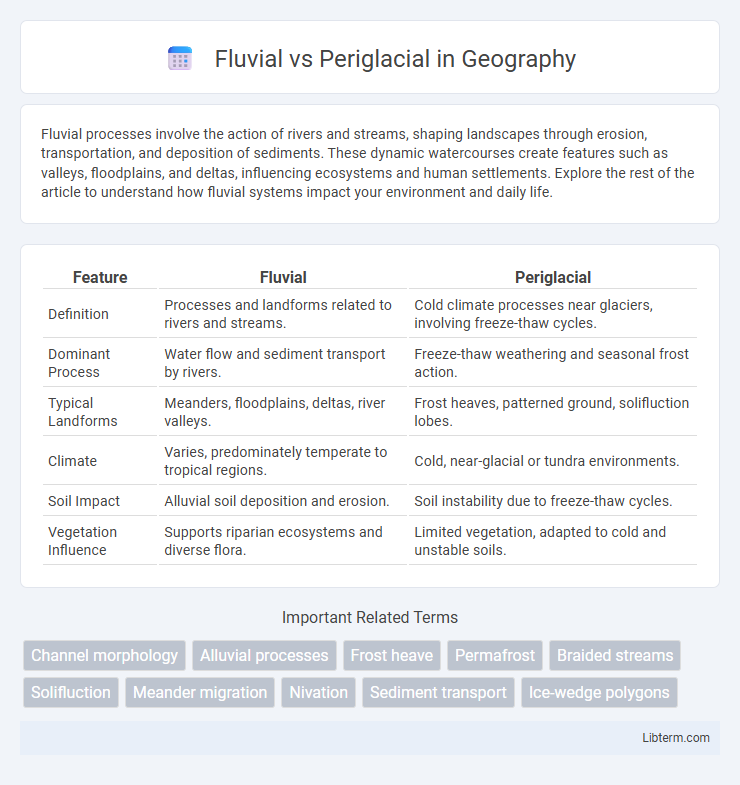Fluvial processes involve the action of rivers and streams, shaping landscapes through erosion, transportation, and deposition of sediments. These dynamic watercourses create features such as valleys, floodplains, and deltas, influencing ecosystems and human settlements. Explore the rest of the article to understand how fluvial systems impact your environment and daily life.
Table of Comparison
| Feature | Fluvial | Periglacial |
|---|---|---|
| Definition | Processes and landforms related to rivers and streams. | Cold climate processes near glaciers, involving freeze-thaw cycles. |
| Dominant Process | Water flow and sediment transport by rivers. | Freeze-thaw weathering and seasonal frost action. |
| Typical Landforms | Meanders, floodplains, deltas, river valleys. | Frost heaves, patterned ground, solifluction lobes. |
| Climate | Varies, predominately temperate to tropical regions. | Cold, near-glacial or tundra environments. |
| Soil Impact | Alluvial soil deposition and erosion. | Soil instability due to freeze-thaw cycles. |
| Vegetation Influence | Supports riparian ecosystems and diverse flora. | Limited vegetation, adapted to cold and unstable soils. |
Introduction to Fluvial and Periglacial Processes
Fluvial processes involve the movement and deposition of sediments by rivers and streams, shaping landscapes through erosion, transportation, and sedimentation. Periglacial processes occur in cold, non-glacial environments where freeze-thaw cycles and ice-wedge formations dominate soil and surface dynamics. Understanding the mechanisms of fluvial erosion and periglacial frost action is essential for interpreting geomorphological features in respective climatic zones.
Defining Fluvial Environments
Fluvial environments are defined by the processes related to rivers and streams, characterized by the movement and deposition of sediment through flowing water. These dynamic systems shape valleys, floodplains, and deltas, influencing sediment transport, channel morphology, and aquatic ecosystems. In contrast, periglacial environments are dominated by freeze-thaw cycles and the presence of permafrost, affecting soil stability and landscape features without the continuous flow of liquid water found in fluvial systems.
Understanding Periglacial Landscapes
Periglacial landscapes are characterized by intense freeze-thaw cycles that shape the terrain through processes like frost heaving and solifluction, creating features such as patterned ground and ice wedges. Unlike fluvial environments dominated by water flow erosion and deposition, periglacial regions experience limited liquid water movement but extensive cryogenic activity influencing soil and rock structures. This understanding is crucial for interpreting permafrost dynamics, sediment transport, and geomorphological evolution in cold-climate ecosystems.
Key Differences Between Fluvial and Periglacial Systems
Fluvial systems are characterized by the movement and deposition of sediment through flowing water in rivers and streams, primarily shaping landscapes via erosion and sediment transport. Periglacial systems, found in cold climates near glaciers, are dominated by freeze-thaw processes, frost action, and patterned ground formation, impacting soil and sediment stability without permanent water flow. The key difference lies in the dominant geomorphic agents: fluvial systems rely on liquid water flow, while periglacial systems are governed by freeze-thaw cycles and cold-climate physical processes.
Geomorphic Features of Fluvial Regions
Fluvial regions exhibit geomorphic features shaped primarily by river and stream activity, including well-defined river valleys, floodplains, meanders, oxbow lakes, and alluvial fans. These landscapes are characterized by sediment transport and deposition, creating layered terraces and levees that influence drainage patterns and soil fertility. Erosional and depositional processes in fluvial environments result in dynamic landforms that contrast sharply with the freeze-thaw influenced, patterned ground typical of periglacial regions.
Landforms Characteristic of Periglacial Zones
Periglacial landforms are characterized by features such as patterned ground, ice wedges, and solifluction lobes, which result from freeze-thaw cycles in cold, non-glacial environments. These formations indicate intense frost action and seasonal soil movement, contrasting with fluvial landforms shaped primarily by running water. Periglacial zones often exhibit permafrost presence and cryoturbation, differentiating them from the alluvial sediments and river terraces typical of fluvial landscapes.
Climate Influence on Fluvial and Periglacial Processes
Fluvial processes are heavily influenced by climate, as precipitation levels and temperature fluctuations directly affect river discharge, sediment transport, and erosion rates. Periglacial processes depend on cold climates with freeze-thaw cycles that shape soil and rock through frost heaving, solifluction, and patterned ground formation. The distribution and intensity of these processes are dictated by climatic conditions, with fluvial systems dominating in temperate and tropical zones, while periglacial activity prevails in polar and subpolar regions.
Sediment Transport: Fluvial vs Periglacial Dynamics
Fluvial sediment transport primarily involves water flow in rivers and streams, where sediments are eroded, carried, and deposited based on current velocity and discharge variations. Periglacial sediment dynamics are dominated by freeze-thaw cycles, solifluction, and gelifluction, moving sediments through processes like frost heave and meltwater flow in cold environments. The key difference lies in the dominant agent: fluvial systems rely on continuous liquid water flow, whereas periglacial systems depend on seasonal thermal fluctuations and ice-related processes for sediment mobilization.
Human Impacts on Fluvial and Periglacial Landscapes
Human activities significantly alter fluvial landscapes through dam construction, river channelization, and water extraction, disrupting natural sediment transport and aquatic ecosystems. In periglacial landscapes, infrastructure development and resource extraction accelerate permafrost thaw, leading to increased erosion, ground subsidence, and release of greenhouse gases. These anthropogenic impacts contribute to landscape instability, loss of biodiversity, and altered hydrological cycles in both environments.
Conclusion: Fluvial vs Periglacial Significance in Geomorphology
Fluvial processes significantly shape landscapes through the continuous movement of water, creating features like river valleys, floodplains, and deltas, essential for understanding sediment transport and erosion dynamics. Periglacial environments influence geomorphology by inducing freeze-thaw cycles, solifluction, and patterned ground formations, which alter soil structures and ground surfaces in cold climates. Recognizing the differences between fluvial and periglacial processes is crucial for interpreting landscape development, predicting environmental change, and managing natural resources in diverse climatic regions.
Fluvial Infographic

 libterm.com
libterm.com